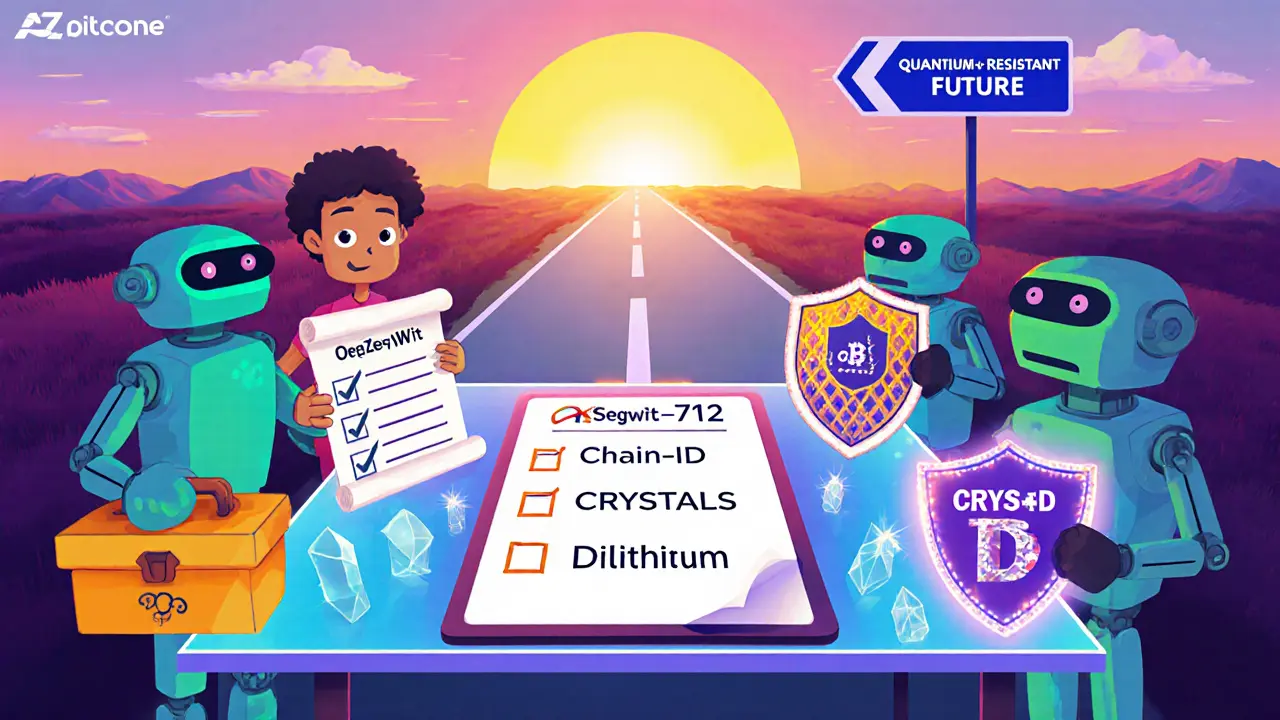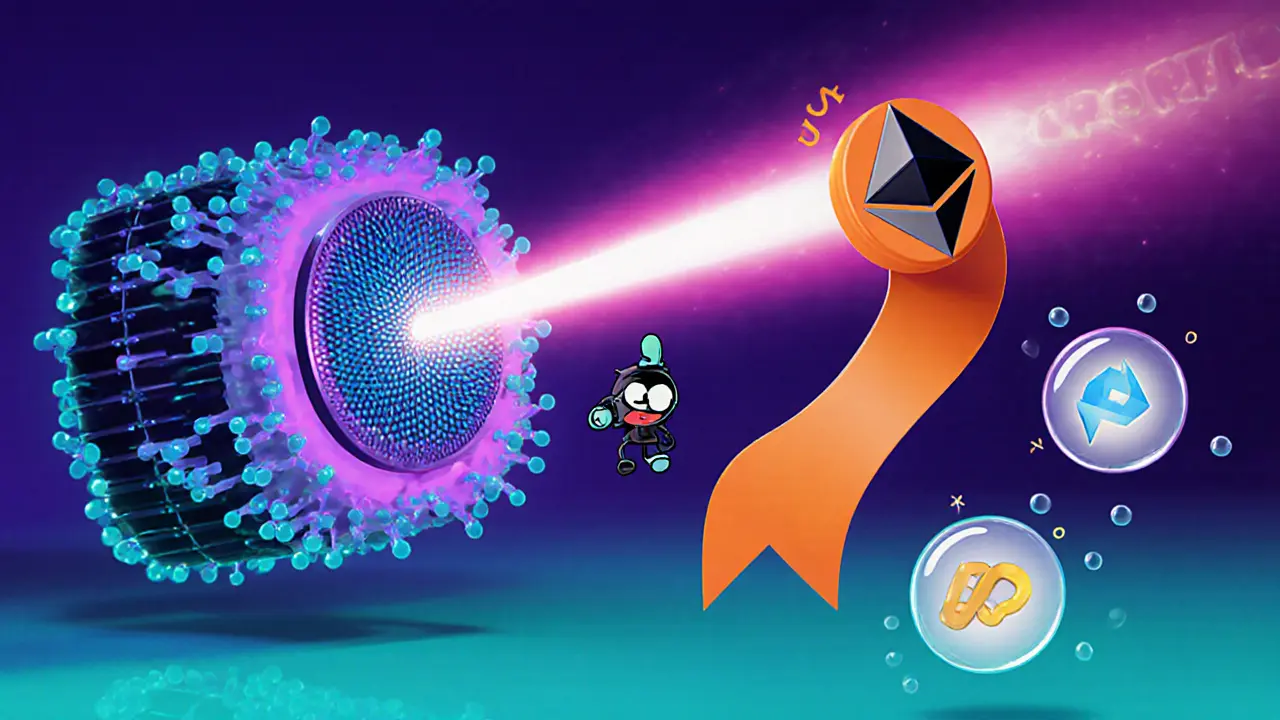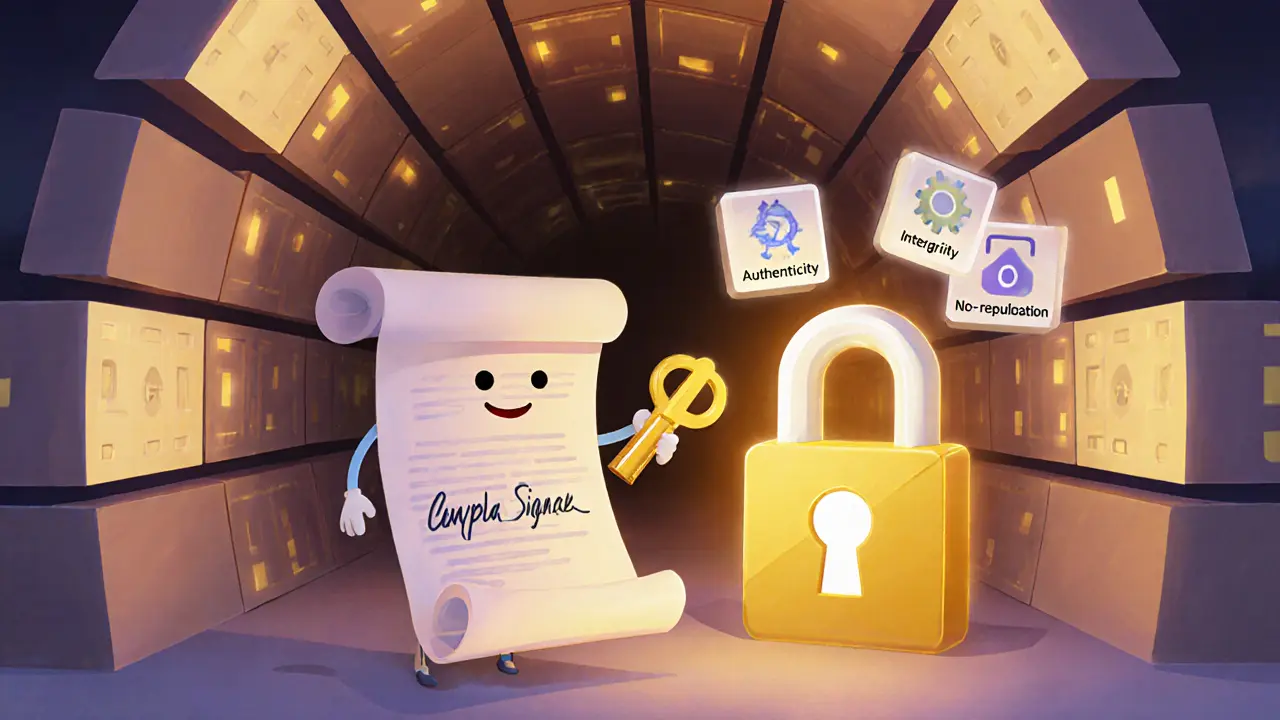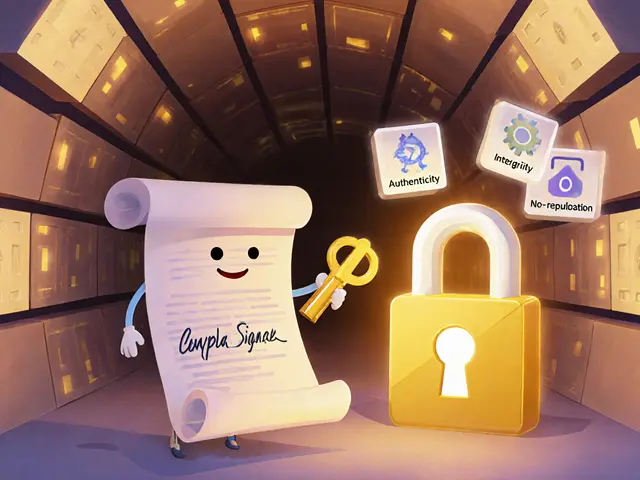Quantum Threat Window Calculator
Calculate Your Quantum Threat Window
This calculator estimates the time window between when a signature is harvested and when it could be decrypted by a quantum computer. The longer the window, the higher the risk of "harvest-now, decrypt-later" attacks.
Recommendations
Key Takeaways
- Three main vulnerability classes dominate crypto: quantum‑computing threats, signature malleability, and cross‑chain replay.
- Over 80% of top‑50 cryptocurrencies still rely on ECDSA or EdDSA, which are vulnerable to future quantum attacks.
- Upgrading to post‑quantum schemes such as CRYSTALS‑Dilithium can shrink the attack window but increases transaction size.
- Adopting standards like BIP143, EIP‑712, and Schnorr signatures cuts malleability risk by >99%.
- Real‑world hacks - from the 2014 Bitcoin ID tweak to the 2022 Poly Network replay - show that weak signatures can drain millions in seconds.
What a Digital Signature Does in Crypto
In a blockchain, a digital signature is a cryptographic proof that a transaction was created by the holder of a private key and hasn’t been altered. It gives three guarantees: authenticity (who signed), integrity (message unchanged), and non‑repudiation (signer can’t deny). Without a reliable signature, anyone could forge transfers, rewrite transaction histories, or freeze a network.
Quantum‑Computing Threats: Why Yesterday’s Algorithms Are Tomorrow’s Weakness
Most legacy blockchains use ECDSA (Elliptic Curve Digital Signature Algorithm) or EdDSA (Edwards‑Curve Digital Signature Algorithm). Both rely on the difficulty of the discrete‑logarithm problem, which Shor’s algorithm can solve in polynomial time on a sufficiently large quantum computer.
Research from Kearney & Perez‑Delgado (2021) shows that a 4,000‑qubit machine could break a 256‑bit ECDSA key in under an hour. Deloitte’s 2023 analysis translates that into a practical window: a Bitcoin transaction (10‑minute block time) could be hijacked within roughly 20 minutes if an attacker harvested the signature and waited for a quantum break.
Frontiers in Computer Science (Jan2025) found that 87% of the top 50 cryptocurrencies still use quantum‑vulnerable schemes. The “harvest‑now, decrypt‑later” model means attackers are already storing signatures for future decryption, turning today’s harmless data into tomorrow’s gold.
Signature Malleability: Manipulating a Valid Signature Without Breaking Cryptography
Malleability doesn’t need a quantum computer - it exploits how a signature is encoded. The 2014 Bitcoin transaction‑ID manipulation let miners change the “s” value of an ECDSA signature, creating a new transaction hash while keeping the signature valid. Chainalysis data says 29% of pre‑2017 Bitcoin transactions were exposed.
The Parity Multisig Wallet hack (July2017) leveraged a verification bug to steal 153,037ETH. In DeFi, 34% of protocol‑level hacks in 2023 were linked to malleability, according to Trail of Bits (2024).
Mitigations include SegWit (BIP‑143) and Schnorr signatures, which lock down the signature format. SegWit cut malleability risk by 92%; Schnorr, adopted in Bitcoin via BIP‑340 (Nov2021), reduced it by 99.8% (Blockstream, 2023).
Cross‑Chain Replay Attacks: One Signature, Many Chains
A replay attack re‑uses a valid signature on a different blockchain that shares the same address format. The 2022 Poly Network incident showed attackers moving $80million across Ethereum, BSC, and Polygon by replaying the same signed instruction.
Ethereum’s EIP‑712 (2019) introduced a domain separator that embeds the chain ID, mitigating replay for new contracts. Yet Immunefi (2024) reports that 41% of contracts deployed before 2020 still lack this protection.
Best practice: always include a unique chain identifier and a nonce in the signed payload.
Comparing Signature Schemes: Classical vs Post‑Quantum
| Scheme | Security (Classical) | Quantum Resistance | Signature Size | Adoption (2024) |
|---|---|---|---|---|
| ECDSA | 256‑bit | Vulnerable | ~72bytes | ≈85% of top‑50 |
| Schnorr | 256‑bit | Vulnerable | ~64bytes | Adopted by Bitcoin (2021) |
| CRYSTALS‑Dilithium | 256‑bit (post‑quantum) | Quantum‑resistant (NIST‑selected) | ~2,420bytes | Pilot in Ethereum, Polkadot (2024‑2025) |
Switching to Dilithium adds about 33× the data payload, which raises bandwidth and storage costs. Projects must balance security against performance.

Real‑World Hacks: Lessons Learned
- 2014 Bitcoin ID tweak: showed that even a well‑designed blockchain can be undermined by signature flexibility.
- 2017 Parity Multisig bug: a single verification error cost $31M.
- 2020 Lazarus Group DeFi attacks: exploited poor validation in multiple protocols, stealing $12.5M.
- 2022 Poly Network replay: demonstrated the danger of chain‑agnostic signatures.
- 2023 Curve Finance drain: signature validation flaw drained $67M, prompting users to migrate to hardened wallets.
Each incident shares a common theme: developers either omitted critical parameters (chain ID, nonce) or used custom verification code instead of battle‑tested libraries.
Mitigation Playbook for Developers and Operators
- Use audited libraries. OpenZeppelin’s Signature Security Guide (Mar2024) reduces bugs by 63% when followed.
- Adopt standardized message formats. EIP‑712 for Ethereum, BIP‑143/SegWit for Bitcoin, and future EIP‑7702 for account abstraction.
- Implement chain‑specific domain separators. Include
chainId,contractAddress, and a uniquenoncein every signed payload. - Plan for quantum migration. Begin testing CRYSTALS‑Dilithium or other lattice‑based schemes now; the transition can cost $2.3‑4.7M per blockchain and take 18‑24 months.
- Enable multi‑signature aggregation. Schnorr signatures support batch verification, cutting verification gas by up to 80%.
- Run regular signature audits. Use tools like SigCheck (funded by the Ethereum Foundation) to scan smart contracts before deployment.
- Educate end‑users. Wallet UI should display chain IDs and highlight replay‑risk warnings.
Following this checklist slashes the attack surface and aligns with upcoming regulatory mandates (SEC 2024, EU MiCA 2025).
Future Outlook: When Will Quantum Break the Chains?
Experts differ. Dr. Michele Mosca (2023) assigns a 60% chance of a break‑capable quantum computer by 2029. NIST (2024) says the threat is not immediate but migration must start now because crypto ecosystems have 10‑15‑year rollout cycles.
Industry forecasts:
- Gartner predicts 75% of major blockchains will adopt quantum‑resistant signatures by 2030.
- Deloitte’s conservative view caps adoption at 43% by 2032.
In the meantime, “harvest‑now, decrypt‑later” attacks are already gathering billions of signatures. CipherTrace (2024) estimates 18.7million Bitcoin addresses are exposed today, meaning the window for preventive action is narrowing.

Quick Checklist for Audits
| Item | Check |
|---|---|
| Signature algorithm documented? | Yes / No |
| Domain separator includes chain ID? | Yes / No |
| Nonce or replay protection present? | Yes / No |
| Uses audited library (OpenZeppelin, etc.)? | Yes / No |
| Quantum‑resistant testnet deployed? | Yes / No |
Frequently Asked Questions
Why are ECDSA signatures vulnerable to quantum computers?
ECDSA’s security relies on the difficulty of solving the elliptic‑curve discrete logarithm problem. Shor’s algorithm can solve this problem in polynomial time, so a sufficiently powerful quantum computer can derive the private key from a public key and forge signatures.
What is signature malleability and how does SegWit fix it?
Malleability lets an attacker tweak certain fields (like the ‘s’ value) of a valid ECDSA signature, producing a new transaction hash while keeping the signature valid. SegWit moves the signature data outside the transaction hash calculation, so changes no longer affect the transaction ID.
How does EIP‑712 prevent replay attacks?
EIP‑712 defines a typed data structure that includes a domain separator containing the chain ID, contract address, and a salt. Because the signature covers these fields, the same signed message cannot be replayed on a different chain or contract.
When should a blockchain start testing post‑quantum signatures?
Ideally now. Migration projects take 18‑24 months and cost millions. Starting tests on testnets and hybrid deployments ensures a smooth switch before quantum‑capable hardware appears, which experts project could happen as early as 2029.
Are Schnorr signatures quantum‑safe?
No. Schnorr improves malleability and enables signature aggregation, but it still relies on discrete‑logarithm hardness and thus remains vulnerable to quantum attacks.
Next Steps for Your Project
If you’re building a new token, start with EIP‑712 or BIP‑143‑style domain separators and integrate OpenZeppelin’s signature utilities from day one. For legacy chains, migrate high‑value wallets to SegWit or Schnorr first, then schedule a phased rollout of a post‑quantum scheme. Keep an eye on NIST’s final guidance and test hybrid signatures on a dedicated testnet before committing to mainnet changes.


Comments
Lock down your hash function choices right now; weak hashes are the low‑hanging fruit for attackers. No excuses, get it done.
When we contemplate the quantum horizon, we see that the mere existence of a threat window forces us to rethink the temporal assumptions baked into our protocols. It is not just a technical tweak, it is a philosophical shift in how we perceive future security.
Alright, listen up, because there’s a lot of nonsense floating around about "digital signatures are safe forever" – that’s just not true. First, most implementations still rely on RSA‑1024 or ECDSA curves that are on the brink of being obsolete once a decent quantum computer shows up. Second, the whole idea of a "harvest‑now, decrypt‑later" attack means your signature could be sitting in a cache somewhere, waiting for a future break. Third, the calculator you posted is cute, but it assumes linear scaling of quantum resources, which many experts think is overly optimistic. Fourth, the block time you feed in is often an average, not the worst‑case scenario; an attacker can target high‑value blocks with longer exposure. Fifth, many developers forget to rotate keys, so the same key may be used for years, expanding the threat window dramatically. Sixth, side‑channel leaks in the signing process can give away partial key material, shortening the time needed for a quantum attack. Seventh, the recommended "risk assessment" is vague – what does "medium" actually mean in practice? Eighth, you need to consider post‑quantum migration paths now, not later, because the transition will be painful. Ninth, there’s the matter of certificate revocation – if a signature is compromised, revoking it in a decentralized system is a nightmare. Tenth, the calculator doesn’t factor in potential improvements in error‑corrected quantum algorithms that could shave off minutes from the attack time. Eleventh, even classical attacks like lattice reduction still pose a threat to certain curves, so you’re not just fighting quantum, you’re fighting a multi‑front war. Twelfth, the UI lacks guidance on how to choose appropriate block‑time parameters for different blockchains. Thirteenth, the threat window output is in minutes, but real‑world attackers think in days or weeks, so the metric might be misleading. Fourteenth, you should also be aware of hardware security modules that may have their own quirks when exposed to quantum‑era threats. Fifteenth, and finally, the whole ecosystem needs better education – most developers still think "quantum‑resistant" means "just use a bigger key". So, bottom line: don’t rely on this calculator as your sole security gauge; dig deeper, audit the code, and start planning for post‑quantum algorithms now.
From an engineering standpoint, the risk assessment should be tied to concrete SLAs. If your window exceeds the time it takes for a quantum processor to solve the underlying lattice problem, you need to enforce immediate key rotation. Also, documenting the assumptions in the calculator helps auditors trace the security rationale.
Hey folks, just a quick heads‑up: if you’re still on NIST‑P‑256, you’re basically handing a future quantum adversary a pass. Switch to a post‑quantum scheme like Dilithium or Falcon, and you’ll close the window dramatically. Also, make sure your libraries are up‑to‑date – old OpenSSL versions have known issues with side‑channel leakage.
I concur with the recommendation to migrate to post‑quantum algorithms, but let’s not forget the operational overhead. Integrating Dilithium into legacy pipelines can introduce serialization quirks and compatibility headaches. A phased rollout with thorough testing is essential to avoid service disruption.
While the technical depth is admirable, I’d argue that the calculator’s focus on minutes oversimplifies the real risk. Attackers care about the economic feasibility, not just raw computation time. If the cost to run a quantum attack is prohibitive, the practical threat diminishes, regardless of the theoretical window.
Lock‑down your signatures or else the whole thing collapses – you’re basically inviting a quantum hack if you ignore the obvious warnings. Most users won’t even realize the danger until it’s too late.
Gotcha, that’s a solid point about the migration costs. We should probably draft a roadmap that balances security upgrades with minimal downtime.
In accordance with established cryptographic standards, it is imperative to adopt post‑quantum primitives promptly; any delay compromises the integrity of the entire system.
Great discussion! 🌟 Keep pushing forward, the community thrives on these insights. 👍
Indeed, the collective wisdom here highlights both the urgency and the pragmatic steps needed. Let’s not forget to document each phase for future audits.
One must acknowledge the theatricality in the presentation of these calculators; yet, beneath the flamboyance lies a stark reality: the cryptographic community has been warned for years, and complacency has persisted. It is high time we elevate discourse from mere speculation to decisive action, lest we become historical footnotes in a narrative of avoidable failure.
Consider the geopolitical implications before you hesitate.